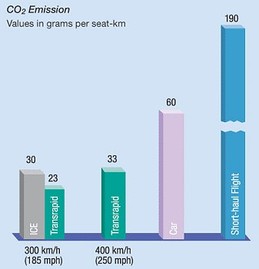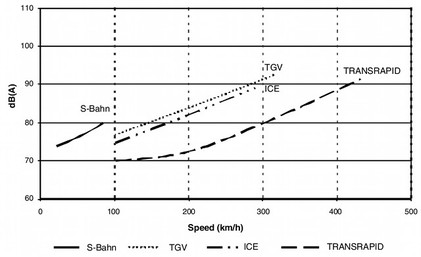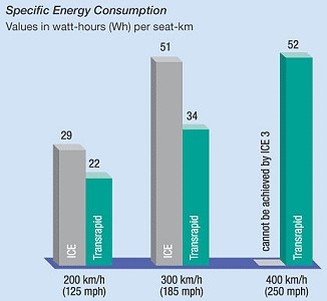Social and environmental benefits
|
Environmental
Maglev trains create no direct pollution emissions and are significantly quieter than traditional transport methods when operating at the same speed. Using this high-speed train as an intercity transport system can create a surplus to a cost-benefit ratio, in regards to land purchase, construction, operation, maintenance and environmental protection. There is also potential for future technological advances to improve this ratio even more. Energy Consumption Energy consumption is one of the most important factors to consider in regards to environmental impacts, as it will significantly reduce the effects that the current transport systems are having on global warming. |

Carbon Dioxide Emissions
Carbon Dioxide emissions are another very important factor when considering the benefits of the Maglev train as these gasses contribute directly to the greenhouse effect.
This graph directly compares the CO2 emissions of the Maglev, traditional Inter City express train, an average motor car and a short haul airliner flight in grams per seat kilometers.
The Maglev has significantly lower CO2 emissions compared too the traditional InterCity train at 300 kph, mainly due to its lower energy usage. At 400 kph the Maglev has almost half the CO2 emissions than an average motor car and a massive five and a third times less than a short haul airline flight.The Maglev train is also highly reliable having no mechanical contact points with a track to wear out, or any electrical cables to pick up, unlike the traditional Inter City train which could lead to even more pollution.
Carbon Dioxide emissions are another very important factor when considering the benefits of the Maglev train as these gasses contribute directly to the greenhouse effect.
This graph directly compares the CO2 emissions of the Maglev, traditional Inter City express train, an average motor car and a short haul airliner flight in grams per seat kilometers.
The Maglev has significantly lower CO2 emissions compared too the traditional InterCity train at 300 kph, mainly due to its lower energy usage. At 400 kph the Maglev has almost half the CO2 emissions than an average motor car and a massive five and a third times less than a short haul airline flight.The Maglev train is also highly reliable having no mechanical contact points with a track to wear out, or any electrical cables to pick up, unlike the traditional Inter City train which could lead to even more pollution.

Noise Pollution
Although noise pollution does not directly impact on the global climate in the way that CO2 emissions do, it has adverse effects of the local environment for those who live in it. It can also have a detrimental effect on local fauna altering or destroying a local ecosystem.
Maglev trains have no noise problems, as there is no friction between the trolley and pantograph, neither does it have any noise from rolling friction. The only possible noise may be from the trains aerodynamics.
Land Take
This is how much land the systems take up when being built, hence the possibility to destroy natural habitats. Thus making it important to construct and expand on existing transport networks. The Maglev only requires a 12m wide dual guideway compared to the normal rail system requires a 14m wide land take, and 4 lane freeways require a 30m wide land take (Geerlings, H. 1998). Thus meaning that the Maglev has far less environmental impact on land when it is being built compared to the traditional train method and highways.
Political Effects
One negative that has been discussed is the effect on public health over fears of radiation from passing trains, despite the lack of any scientific evidence that this is even possible. When the Chinese government initially put forward this idea to extend the Maglev line through residential areas there was initial backlash from residents who feared the adverse health effects from radiation. The Maglev was given final approval n 2008.
However, the fact that the Maglev train produces far less CO2 emissions, have a smaller land take requirement, and are far quieter than alternative methods, the Maglev has meet far less opposition than its potential alternatives.
Financial Effects
The major negative with the Maglev is the cost of the guide rail. The current track costs 310 million yuan ($39 million) per kilometre, this includes the cost of setting up infrastructure and maintenance facilities. The Maglev was estimated to to cost 200 million yuan ($25 million) per kilometre (China Masters German Train Technology, Will Cut Costs, 2006). Although this is still expensive, it is significantly less than comparative constructions. For example the Hog King airport cost $20 billion and the interstate highway cost $31 million to build. These costs make it expensive to build on a route that already has an expensive infrastructure built such as existing transport lines, it does still make a competitive option for a route that has no infrastructure. This is an ideal option for countries with developing infrastructure such as China.
Although noise pollution does not directly impact on the global climate in the way that CO2 emissions do, it has adverse effects of the local environment for those who live in it. It can also have a detrimental effect on local fauna altering or destroying a local ecosystem.
Maglev trains have no noise problems, as there is no friction between the trolley and pantograph, neither does it have any noise from rolling friction. The only possible noise may be from the trains aerodynamics.
Land Take
This is how much land the systems take up when being built, hence the possibility to destroy natural habitats. Thus making it important to construct and expand on existing transport networks. The Maglev only requires a 12m wide dual guideway compared to the normal rail system requires a 14m wide land take, and 4 lane freeways require a 30m wide land take (Geerlings, H. 1998). Thus meaning that the Maglev has far less environmental impact on land when it is being built compared to the traditional train method and highways.
Political Effects
One negative that has been discussed is the effect on public health over fears of radiation from passing trains, despite the lack of any scientific evidence that this is even possible. When the Chinese government initially put forward this idea to extend the Maglev line through residential areas there was initial backlash from residents who feared the adverse health effects from radiation. The Maglev was given final approval n 2008.
However, the fact that the Maglev train produces far less CO2 emissions, have a smaller land take requirement, and are far quieter than alternative methods, the Maglev has meet far less opposition than its potential alternatives.
Financial Effects
The major negative with the Maglev is the cost of the guide rail. The current track costs 310 million yuan ($39 million) per kilometre, this includes the cost of setting up infrastructure and maintenance facilities. The Maglev was estimated to to cost 200 million yuan ($25 million) per kilometre (China Masters German Train Technology, Will Cut Costs, 2006). Although this is still expensive, it is significantly less than comparative constructions. For example the Hog King airport cost $20 billion and the interstate highway cost $31 million to build. These costs make it expensive to build on a route that already has an expensive infrastructure built such as existing transport lines, it does still make a competitive option for a route that has no infrastructure. This is an ideal option for countries with developing infrastructure such as China.

